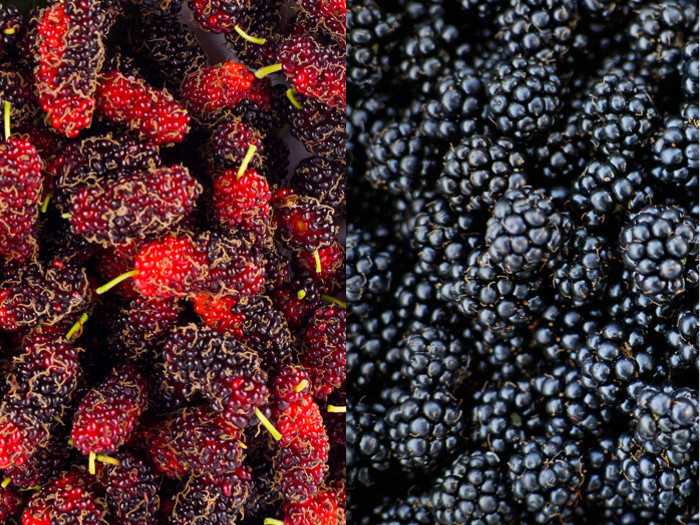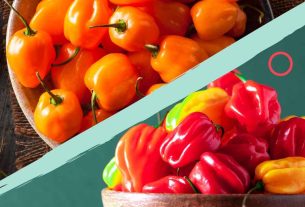Mulberry versus blackberry, a delicious duel that unleashes a fruity frenzy.
Picture yourself strolling through a vibrant orchard, the sweet aroma of mulberries kissing your senses, while a tantalizing trail of blackberries beckons from a thorny thicket nearby.
Discover the contrasting tastes and distinct characteristics of these remarkable fruits as we delve into their world, brimming with tantalizing health benefits.
Prepare to tantalize your taste buds and embrace the bountiful beauty of mulberries and blackberries in this enthralling exploration!
mulberry vs blackberry
Mulberries and blackberries are two different fruits with distinct flavors.
Mulberries have a more vegetal and grassy taste, while blackberries are sweet with a jammy and peppery flavor.
Mulberries grow on trees, while blackberries grow on bushes or brambles.
Blackberries are considered an “aggregate fruit” with many smaller fruit pods connected to a central stem.
Mulberries come in dark purple, red, and white colors when underripe, whereas blackberries ripen from green to red and finally become deep purple/black when ripe.
Additionally, mulberries have a shorter shelf life, reaching up to 3-5 days, while blackberries can be refrigerated for longer.
Despite these differences, both fruits offer health benefits and can be found growing wild or cultivated domestically.
Key Points:
- Mulberries and blackberries have distinct flavors: mulberries have a vegetal and grassy taste, while blackberries are sweet with a jammy and peppery flavor.
- Mulberries grow on trees, while blackberries grow on bushes or brambles.
- Blackberries are an “aggregate fruit” with many smaller fruit pods connected to a central stem.
- Mulberries come in dark purple, red, and white colors when underripe, while blackberries ripen from green to red and finally become deep purple/black when ripe.
- Mulberries have a shorter shelf life of 3-5 days, while blackberries can be refrigerated for longer.
- Despite the differences, both fruits offer health benefits and can be found growing wild or cultivated domestically.
mulberry vs blackberry – Watch Video
💡
Pro Tips:
1. Mulberries and blackberries are not only different in color, but also in their origins. Mulberries come from the Morus tree, while blackberries come from the Rubus genus of plants.
2. Mulberries have a long history of cultivation, dating back thousands of years. They were originally grown in China and later introduced to other parts of the world by traders along the Silk Road.
3. Believe it or not, mulberries are capable of changing color during the ripening process. They start off as green, then turn red, and finally mature into a dark purple or black, depending on the variety.
4. Blackberries are often referred to as “aggregate fruits” because they are composed of multiple small drupelets that cluster together. Each drupelet in a blackberry contains its own seed, making them a bit more complex than the single-seeded mulberry fruit.
5. While both fruits are delightful, mulberries and blackberries differ in their taste profiles. Mulberries are known for their mild and slightly sweet flavor, whereas blackberries have a sharper, tangier taste. Some might say that blackberries have a more intense flavor than their mulberry counterparts.
Flavor Differences: Mulberries Vs Blackberries
Mulberries and blackberries are two distinct fruits that offer unique flavors. Mulberries have a more vegetal and grassy taste, which sets them apart from the sweet and jammy flavor of blackberries. The peppery undertones in blackberries enhance their overall flavor profile, creating a delightful contrast. These distinct flavors make mulberries and blackberries versatile ingredients in various culinary creations.
- Mulberries offer a vegetal and grassy taste.
- Blackberries have a sweet and jammy flavor.
- Blackberries have peppery undertones that enhance their flavor.
- Mulberries and blackberries can be used in a variety of culinary creations.
“Mulberries and blackberries offer unique and distinct flavors, making them versatile ingredients in culinary creations.“
Growth Patterns: Trees Vs Bushes
One of the notable differences between mulberries and blackberries lies in their growth patterns. Mulberries flourish on trees, while blackberries thrive on bushes or brambles. The tall and stately presence of mulberry trees presents a stark contrast to the low-growing and sprawling nature of blackberry bushes. This distinction in growth patterns contributes to the unique characteristics of each fruit.
- Mulberries grow on trees.
- Blackberries grow on bushes or brambles.
“The tall and stately presence of mulberry trees presents a stark contrast to the low-growing and sprawling nature of blackberry bushes.”
Anatomy: Aggregate Fruit Structure Of Blackberries
Blackberries are categorized as “aggregate fruits” due to their unique anatomical structure. They consist of numerous smaller fruit pods interconnected by a central stem. This intricate arrangement creates a cluster-like appearance, giving blackberries their distinctive texture and appearance. The aggregate structure of blackberries is an interesting aspect that sets them apart from other fruits.
Cultivation: Bramble Vs Trellis System
When it comes to cultivation, blackberries can be grown using two distinct approaches. They can either be grown on a bramble, which involves allowing the bushes to grow wild, or on a trellis system, where the bushes are supported and trained to grow vertically. This flexibility in cultivation methods makes blackberries a popular choice among farmers and gardeners, as they can adapt to different environments.
Blackberry Harvest Time: June To August In North America
In North America, blackberries grace the market shelves from June to August. This limited harvest season adds to the allure of blackberries and makes them a highly anticipated summertime delight. As the days grow longer and warmer, the blackberries gradually reach their peak, offering a window of time to indulge in their succulent flavors.
Blackberry Color Transformation: From Green To Deep Purple/Black
Blackberries undergo a mesmerizing color transformation as they ripen. Beginning as green buds, they gradually transition to a vivid red shade before ultimately maturing into a deep purple or black hue. This visual journey reflects the development of the fruit and signifies the perfect stage for consumption. The final deep purple or black color indicates the optimal time to savor the rich flavors of blackberries.
- Blackberries transition from green to red before maturing into purple or black.
- The color transformation reflects the development of the fruit.
- Deep purple or black indicates the best time to enjoy the flavors.
“Pick Your Own” Blackberries: Offered By Farmers During Season
To encourage engagement with the harvest season, many blackberry farmers offer the delightful experience of “pick your own” blackberries. This activity allows individuals to visit the farm, handpick their own blackberries, and enjoy the pleasure of connecting with nature. It also enables customers to select the ripest and juiciest fruits, ensuring a memorable and fresh culinary experience.
Mulberries As Multiple Fruits: Shaped Like Blackberries
Although commonly referred to as berries, mulberries are not true berries in the botanical sense. Instead, they are multiple or collective fruits that take on the shape of a blackberry. This distinctive characteristic adds to the intrigue surrounding mulberries and distinguishes them from other fruit varieties.
Global Distribution: Mulberry Trees And North America
Mulberry trees are widely distributed around the world, with Asia and Europe being the main regions where they can be found. However, they are relatively less common in North America. The abundance of mulberry trees in these regions has resulted in a diverse range of culinary possibilities. Despite this, their prevalence outside of North America makes them less familiar to many in the Western world.
Comparing Size And Shelf Life: Mulberries Vs Blackberries
In terms of size, mulberries surpass blackberries, reaching up to 2 inches or more in length. This larger size contributes to their distinct appearance and enhances their appeal in culinary presentations. However, mulberries have a relatively short shelf life of 3-5 days, even when refrigerated. Conversely, blackberries boast a longer shelf life, allowing for a greater window of enjoyment.
Mulberries and blackberries are small, dark purple fruits that offer antioxidant benefits and contribute to overall health.
Despite both being commonly referred to as berries, they are, in fact, multiple or aggregate fruits. Each fruit possesses unique flavors and growth patterns, with mulberries growing on trees while blackberries thrive on bushes or brambles.
Their diverse uses, health benefits, and cultivation methods make them delightful additions to any culinary journey.
- Mulberries have a larger size of up to 2 inches or more
- Mulberries have a relatively short shelf life of 3-5 days, even when refrigerated
- Blackberries have a longer shelf life
- Both mulberries and blackberries offer antioxidant benefits
- Mulberries grow on trees while blackberries thrive on bushes or brambles
💡
You may need to know these questions about mulberry vs blackberry
Is mulberry and blackberry the same?
Mulberries and blackberries are not the same. These fruits belong to distinct plant species and have noticeable differences in their growth patterns and physical features. While mulberries grow on trees, blackberries are found on bushes. Furthermore, the shape of mulberries tends to be much longer compared to the average blackberry. Ultimately, these distinctions highlight the unique characteristics that set mulberries and blackberries apart from each other.
Why are mulberries not sold in stores?
Mulberries are notably absent from store shelves primarily due to the challenges associated with harvesting and their short refrigerated shelf life. The fruit’s unique elongated shape, resembling a conifer, grows on various species of mulberry trees that are relatively easy to cultivate. However, the delicate nature of the fruit makes it tricky to harvest efficiently, making it less commercially viable for grocery stores to stock. Additionally, mulberries have a limited refrigerated shelf life of only two to four days, further reducing their availability in stores.
Which is healthier mulberry or blackberry?
Mulberry and blackberry are both incredibly healthy fruits that are packed with beneficial compounds. Their deep colors indicate that they are rich in anthocyanins, flavonoids, and polyphenolic compounds, which are known to have strong antioxidant properties. Both fruits offer similar health benefits, such as improving heart health, boosting the immune system, and protecting against certain chronic diseases. Therefore, it is not possible to deem one as healthier than the other as they both provide valuable nutrients and antioxidants for overall well-being.
What is the difference between mulberry and blueberry?
While both mulberries and blueberries are fruits, they differ in their appearance and taste. Mulberries have a distinct visual resemblance to a longer and slimmer blackberry, lacking the round shape of blueberries. Moreover, mulberries are known for their sweeter taste, setting them apart from the slightly tangy flavor of blueberries.
Reference source
https://thedaringkitchen.com/mulberry-vs-blackberry/
https://a-z-animals.com/blog/mulberry-vs-blackberry-5-key-differences/
https://www.marketplace.org/2022/07/22/why-arent-mulberries-sold-at-grocery-stores/
https://www.emedihealth.com/nutrition/mulberry-vs-blackberry-benefits



